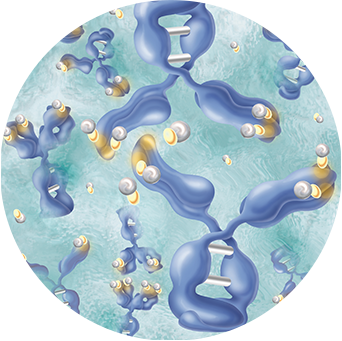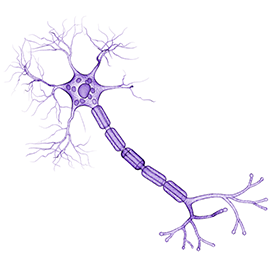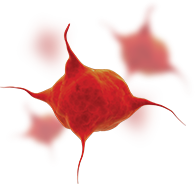The mechanism of action of IgG in primary immunodeficiency (PI) disease has not been fully elucidated. It is known that Privigen provides patients with a broad spectrum of opsonic and neutralizing IgG antibodies against bacterial, viral, parasitic, and mycoplasma agents and their toxins.

The mechanism of action for IgG therapy is complex and not fully understood. However, its success in treating CIDP—an inflammatory neuropathy with an underlying autoimmune basis—is largely attributed to its immunomodulatory effects.3
A more precise mechanism of action regarding just how IgG therapy exerts its immunomodulatory effects is still being explored, but proposed mechanisms that may play a role include3-7:

The mechanism of action of IgG in chronic immune thrombocytopenic purpura (ITP) is complex and not fully understood. However, the success of treating chronic ITP with IgG has been attributed to the competitive inhibition of Fc receptors on phagocytic cells.2,3
Continuing research indicates that other mechanisms may also contribute to thrombocytopenia, including1:
Although IVIg has been used to treat chronic ITP, the mechanism of action is still unclear. Further research will be needed to better understand how IVIg works in chronic ITP.1

References: 1. Simon HU, Späth PJ. IVIG mechanisms of action. Allergy. 2003;58(7):543-552. 2. Maddur MS, Lacroix-Desmazes S, Bayry J, Kaveri SV. Intravenous polyclonal immunoglobulin in autoimmune diseases: clinical indications and mechanisms of action. Drug Discov Today Ther Strateg Autoimmun. 2009;6(1):5-11. 3. Cramer M, Frei R, Sebald A, Maeder M. Stability over 36 months of new liquid 10% polyclonial immunoglobulin product (IgPro10. Privigen®) stabilized with L-proline. Vox Sang. 2009;96(3):219-225. 4. Dalakas MC, Latov N, Kuitwaard K. Intravenous immunoglobulin in chronic inflammatory demyelinating polyradiculoneuropathy (CIDP): mechanisms of action and clinical and genetic considerations. Expert Rev Neurother. 2022 Nov-Dec;22(11-12):953-962. doi:10.1080/14737175.2022.2169134. Epub 2023 Jan 23. PMID: 36645654. 5. Querol L, Hartung H, et al. The role of the complement system in chronic inflammatory demyelinating polyneuropathy: implications for complement-targeted therapies. Neurotherapeutics. 2022 April 12;19:864-873. doi: 10.1007/s13311-022-01221-y. 6. Dalakas MC, Spaeth PJ. The importance of FcRn in neuro-immunotherapies: From IgGcatabolism, FCGRT gene polymorphisms, IVIg dosing and efficiency to specific FcRn inhibitors. Ther Adv Neurol Disord. 2021;14:1756286421997381. Published 2021 Feb 26. doi:10.1177/1756286421997381.
References: 1. Simon HU, Späth PJ. IVIG mechanisms of action. Allergy. 2003;58(7):543-552. 2. Maddur MS, Lacroix-Desmazes S, Bayry J, Kaveri SV. Intravenous polyclonal immunoglobulin in autoimmune diseases: clinical indications and mechanisms of action. Drug Discov Today Ther Strateg Autoimmun. 2009;6(1):5-11. 3. Imbach P, Lazarus AH, Kühne T. Intravenous immunoglobulin induce potentially synergistic immunomodulations in autoimmune disorders. Vox Sang. 2009;98(3):385-394. 4. Dalakas MC, Latov N, Kuitwaard K. Intravenous immunoglobulin in chronic inflammatory demyelinating polyradiculoneuropathy (CIDP): mechanisms of action and clinical and genetic considerations. Expert Rev Neurother. 2022 Nov-Dec;22(11-12):953-962. doi:10.1080/14737175.2022.2169134. Epub 2023 Jan 23. PMID: 36645654. 5. Querol L, Hartung H, et al. The role of the complement system in chronic inflammatory demyelinating polyneuropathy: implications for complement-targeted therapies. Neurotherapeutics. 2022 April 12;19:864-873. doi: 10.1007/s13311-022-01221-y. 6. Dalakas MC, Spaeth PJ. The importance of FcRn in neuro-immunotherapies: From IgGcatabolism, FCGRT gene polymorphisms, IVIg dosing and efficiency to specific FcRn inhibitors. Ther Adv Neurol Disord. 2021;14:1756286421997381. Published 2021 Feb 26. doi:10.1177/1756286421997381.
References: 1. Simon HU, Späth PJ. IVIG mechanisms of action. Allergy. 2003;58(7):543-552. 2. Maddur MS, Lacroix-Desmazes S, Bayry J, Kaveri SV. Intravenous polyclonal immunoglobulin in autoimmune diseases: clinical indications and mechanisms of action. Drug Discov Today Ther Strateg Autoimmun. 2009;6(1):5-11. 3. Jacob S, Rajabally Y. Current proposed mechanism of action of intravenous immunoglobulins in inflammatory neuropathies. Curr Neuropharmacol. 2009;7(4):337-342. 4. Dalakas MC, Latov N, Kuitwaard K. Intravenous immunoglobulin in chronic inflammatory demyelinating polyradiculoneuropathy (CIDP): mechanisms of action and clinical and genetic considerations. Expert Rev Neurother. 2022 Nov-Dec;22(11-12):953-962. doi:10.1080/14737175.2022.2169134. Epub 2023 Jan 23. PMID: 36645654. 5. Querol L, Hartung H, et al. The role of the complement system in chronic inflammatory demyelinating polyneuropathy: implications for complement-targeted therapies. Neurotherapeutics. 2022 April 12;19:864-873. doi: 10.1007/s13311-022-01221-y. 6. Dalakas MC, Spaeth PJ. The importance of FcRn in neuro-immunotherapies: From IgGcatabolism, FCGRT gene polymorphisms, IVIg dosing and efficiency to specific FcRn inhibitors. Ther Adv Neurol Disord. 2021;14:1756286421997381. Published 2021 Feb 26. doi:10.1177/1756286421997381. 7. Matucci A, Maggi E, Vultaggio A. Mechanisms of action of Ig preparations: immunomodulatory and anti-inflammatory effects. Front Immunol. 2015;5:690. Published 2015 Jan 12. doi:10.3389/fimmu.2014.00690.